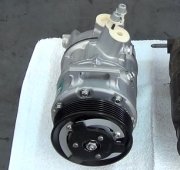Leaving the compressor unplugged is no different than not turning the AC on.
You can also just install a pair if universal, crimp-style terminals on the two wires to replace the original connector. For the diode, we used to buy these 500 at a time to repair lightning-damaged tvs. They cost as little as 15 cents each. There's two ratings when selecting a diode. The first is its current rating. That's how much current it can pass without overheating and shorting. This isn't a big concern in this application because the current in question is the result of the voltage developed by that voltage spike, and that is going to be gone way too quickly to have a chance to develop much current.
The other rating is the voltage. This also is less important in this application. It refers to how much reverse voltage it can withstand before arcing internally and shorting. When the compressor is powered on, the diode here is backward. It has to withstand roughly 14 volts. When we select diodes for their voltage, we're looking at hundreds of volts. Practically any diode you can find will work fine. The 300 volts I mentioned earlier is what could be developed by the voltage spike when there is no diode in the circuit. The object is to short out that spike to 0 volts. That's what the diode does.
There's other diodes all over the vehicle for this purpose. Some are built right into the relays. Yours can be soldered between the two compressor wires. It could be added inside the fuse box if you cared to go through that much work. If you know of anyone who has scrapped out a tv in the past, there's two or four diodes in the power supply, usually near the power cord, that will handle the job. Those 15-cent replacements we bought were rated at 2.5 amps and 1500 volts. That's much higher than what most original diodes are rated for. By the way, for this type of circuit, you need a diode with the ratings specified, as a minimum, but any with higher ratings is just better.
All diodes have some marking to differentiate the "cathode" from the "anode". With a more positive voltage on the anode, the diode will be "forward-biased", meaning current will flow through it. If you put the higher positive voltage on the cathode, as it is in your circuit, it acts like it isn't even there. No current flows through it.
The cathode will have typically a white band around that end. This is the diagram that shows your diode in the circuit. It's right above my blue arrow. It's the horizontal line at the bottom of the triangle. That end gets connected to the dark green wire. The anode gets connected to the black wire.
Image (Click to make bigger)
Wednesday, October 4th, 2023 AT 7:53 PM




